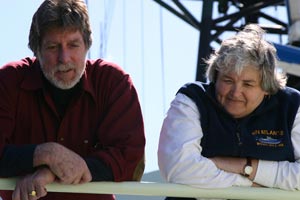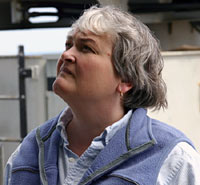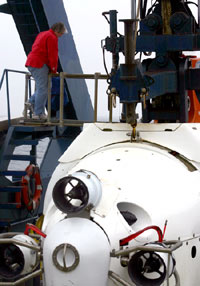Interviews: Chief
Scientist Deborah Kelley
 Chief
scientist Debbie Kelley chats with co-chief John Delaney while
voyaging from Seattle to the study site on the Juan de Fuca Ridge. Chief
scientist Debbie Kelley chats with co-chief John Delaney while
voyaging from Seattle to the study site on the Juan de Fuca Ridge.
Question:
How does a person get to serve as the chief scientist on an oceanographic
research expedition?
Deb:
Whoever takes the lead on a research proposal usually is the chief
scientist. We typically have a co-chief too—in this case,
it is John Delaney. It’s good to have another person to share
ideas with, and decide if a proposed plan is the best one.
I first served as chief scientist two years ago, when the University
of Washington (UW) got a new seafloor mapping system on their ship,
the RV Thompson, and we made a really nice map of the
Endeavour Segment. I was also chief scientist on an expedition
to the Lost
City hydrothermal vent field, and have been co-chief many times.
 |
 |
| The
day before her first Alvin dive of this expedition,
Deb listens as a pilot explains the positioning of the cameras
on the submersible. |
| |
 |
|
Deb
Kelley (left) discusses research with University of Washington
graduate student Deb Glickson. |
| |
 |
| Chief
Scientist Deb Kelly climbs into Alvin for the first dive
of the expedition. She was joined by Co-Chief Scientist John
Delaney and Sub Pilot Patrick Hickey for their journey to
the Mothra hydrothermal vent field at the Endeavour Segment. |
Question:
What are the perks of being chief scientist?
Do you have special privileges?
Deb:
It’s satisfying, in many ways. You get to see a project that
started with a proposal two to four years ago turn into something
special. It’s remarkable when you get to experience the whole
thing coming together. The main special privilege of being chief
scientist on the ship is you get a nice big room with portholes.
It’s also a privilege to have a leadership role and the opportunity
to work with a wonderful group of researchers, students, and crewmembers
onboard.
Question:
How about the biggest challenges of your role?
Deb:
Sometimes great, carefully prepared plans are ruined by broken
equipment or bad weather. Then you have to make tough decisions
that impact people’s science work. Those types of decisions
can add a lot of stress.
Question:
What sparked your interest in ocean research?
Deb:
I didn’t become interested in studying the oceans until my
mid-20s, when I took an oceanography course from John Delaney at
the UW and started going to sea in the summers. I was hooked. We
dredged a lot of volcanic rocks from the ocean bottom, and you
never knew what you’d get. That thrilled me. I was on the
cruise when Margaret Leinen, now Assistant Director of the National
Science Foundation (NSF) dredged up parts of black smokers from
the Endeavour, which lead to the discovery of the Main Endeavour
hydrothermal vent field. I loved that type of discovery process.
Question:
What did you do before studying oceanography?
Deb:
I grew up outside Seattle, in Bellevue. I couldn’t afford
to go to college without financial aide, so I got a scholarship
to study music (the oboe) at Seattle Pacific University. At the
time there were a lot of Russian speaking people living around
this area, so I trained to be an interpreter. Then, because I always
liked art, I ended up going into graphic design at the UW.
During my fourth year, I took a geology class, and I fell in love
with it. I ended up getting my master’s degree in geology,
then got a Ph.D. at Dalhousie University in Halifax, Nova Scotia.
I did post doctoral scholar work at the Woods Hole Oceanographic
Institution before moving back to Seattle in 1992. I finished up
the post doc work at the UW before starting research and teaching
here.
Question:
You have made some incredible science discoveries during expeditions
on board the research vessel Atlantis, including identifying “Lost
City” (a huge hydrothermal vent field located near the Mid-Atlantic
Ridge). What has been your most rewarding moment at sea?
Deb:
Identifying Lost City was, by far, the best experience I’ve
ever had. It was new, it was unexpected, and it was all about being
in the right place at the right time. We were out discovering new
things, people were excited, and that made it really fun.
Question:
For all the “wow” moments, there must be some dull
times too, right?
Deb:
Some of what we do is routine. Sometimes, when the weather is bad,
all we do is mapping, mapping, mapping, which means steering the
ship back and forth in a straight line for hours and days. The
result of this process is a beautiful map of the seafloor, which
always shows us new things, but the process of getting there can
be sometimes tedious. Plus there are all the chores of routine
paper work, which is not necessarily the most fun part of the job.
QUESTION:
You are busy being a leader on this cruise, so when do you have
time to do your own science?
Deb:
It depends on the cruise, and what we were funded to do. We usually
do the highest priority science first. On this cruise, we’re
funded primarily to get the incubators back that are recording
temperatures in the hydrothermal vents, so that’s our highest
priority. The second major goal is to test out some new flow sensors,
so that will happen very early in the cruise also. Then we try
and accommodate what everyone else wants. It’s really a community
decision, and people work together to get the various jobs done.
Question:
I know you look forward to diving in the submersible
Alvin. How many dives have you made using Alvin?
Deb:
About 40—and oh, have I loved every one. One of the
perks of being chief scientist is I’ll be on one of the first
Alvin dives on this cruise.
|
